February, 1937

Hawks-Miller HM-1 "Time Flies"
Model Airplane News Cover Art for February, 1937
by Jo Kotula
Click to Enlarge
In 1936, Hawks approached Howell W. "Pete" Miller, chief engineer for the Granville Brothers and their famous Gee Bee racers, to create a racing aircraft to his own design. Hawks obtained sponsorship from the Gruen Watch Company and [appropriately] named the aircraft "Time Flies". The design featured streamlined lines including the unusual feature of a retractable windshield contoured to fit the fuselage. The M.A.N. Cover makes it look like there is no pilot at all!

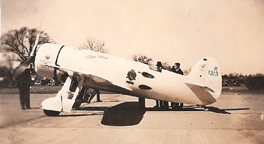
Hawks-Miller HM-1 "Time Flies"
Click to Enlarge
In the early 1930s, Frank Hawks (in his Travel Air Texaco #13) attempted almost every record that could be broken. Hawks wanted to stay at the cutting edge of avaiation technology and reached out to Howell Miller, of the famous Granville Brothers aircraft company that had produced the phenomenal Gee Bee racers. Since both the Granville Brothers had been killed in racing accidents, Miller was left to carry on the tradition. Hawks simply asked for the "fastest airplane in the world."
Nothing in Miller's design induced drag. The landing gear retracted, something quite unusual in 1935. The wind shield was made flush with the top of the fuselage to eliminate any resistance. (For take off and landings, the seat was raised 12" by a hydraulic jack that pushed the cockpit cover upward to form a windshield.) The steel-tube fuselage followed the Granville practice of having its greatest cross section at a point near the mainspar; the skin was specially treated plywood. However, streamlining can only do so much -- the real secret to "Time Flies" was the engine. Hawks finagled permission was from the Army to use a top secret Pratt & Whitney Twin Wasp engine rated at 1150 HP, giving the plane a top speed of 375 mph, an astounding number for 1936.
After the first flight (October 18, 1936), the plane was given registration number NX-2491. A few months later, in a well-publicized venture, Hawks flew from Hartford to Miami in just under five hours. He then flew from Miami to nNewark in 4.5 hours. Unfortunately, a landing accident at Newark, and broke a wooden spar in the right wng. Short of funds, Hawks decided not to rebuild the aircraft. Later, Miller rebuilt the aircraft as a two-seater, the Miller HM-1.
In a sad footnote, Hawks had a great interest in safe airplanes as well as racers. While testing the rather dinky Gwinn Air Car (intended for the masses), he hit a power line on takeoff and was killed. The HM-1 eventually flew faster than 500 mph, but disintegrated in flight. All that is left of either are the pictures shown above.
Click Here for more information about the Hawks-Miller HM-1 "Time Flies".
Our review of Popular Mechanics from 1932-1939 turned up several interesting articles on air racing.
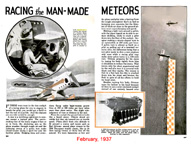
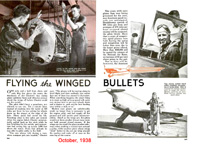
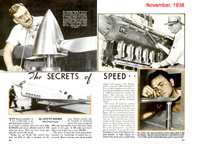
Articles on Air Racing From Popular Mechanics
"Racing the Man-Made Meteors" (February, 1937)
"Flying the Winged Bullets" (October, 1938)
"Secrets of Speed" (November, 1938)
Click to Enlarge
We have scanned these articles anmake them available to you as free downloads
- Click here to download "Racing the Man-Made Meteors"
- Click here to download "Flying the Winged Bullets"
- Click here to download "Secrets of Speed"
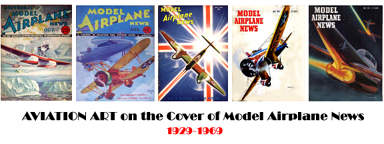
Click to go back and select another cover.
Counter for the Entire Site (not just this page..)
Home | About Lindy | Last Week's Reviews | Upcoming Events | 1940s Collecibles
The Guide - Establishments - Travel - Accessories
Music | Links | Photo Gallery | Extras | Contact